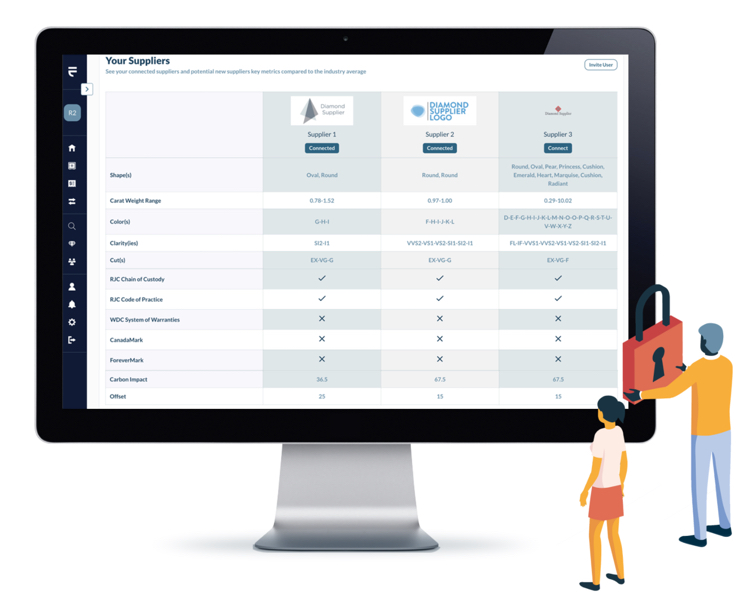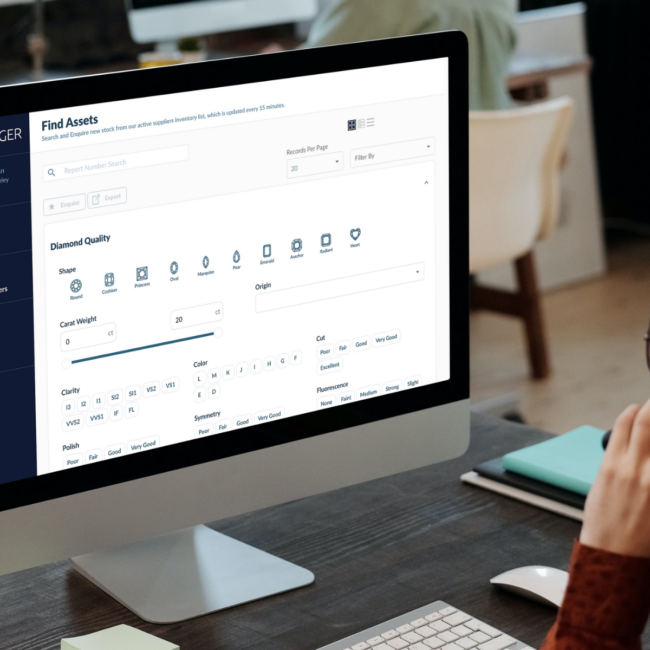
2.0 (Release date: April 2022)
Lab-grown diamonds now on the Everledger Platform
With new, lab-grown diamond provenance reports available for discovery on the Everledger Platform, retailers can discover and display events around carbon seed origin, growth, and an enhancement to the grading event that identifies the stone as being lab grown instead of mined. A departure from supply chain events associated with mined diamonds, the ‘Growing & Cleaning’ event includes details around the technology used to grow the diamond, such as chemical vapour disposition (CVD) versus high-pressure high-heat (HPHT). The ‘Enhancement’ event includes information on added HPHT processes or irradiation.
In future releases, purchasers can easily analyse the lab-grown process by viewing time-stamped events that are captured on the blockchain and retailers can more reliably demonstrate sustainability claims made with that data captured, such as the use of renewable energy in the creation of diamonds.
Bulk transfers
Digital assets can now be moved as a group from one vault to another as an immutable, date-stamped chain of custody event. With the new ability to select more than one asset from the ‘My Vault’ screen using checkbox functionality, users can group transfer digital assets by reviewing their selection and confirming the recipient’s email address for the transfer. From parcels of rough gemstones to pallets of the same SKU, making immutable transfers of ownership in bulk accelerates a transparent path to market that producers and retailers alike can reference for chain-of-custody reporting.

Enhanced greenhouse gas emissions reporting
The latest enhancement to supplier profiles within the Everledger Platform allows producers of any kind of asset to display their use of renewable energy sources versus non-renewable greenhouse gas (GHG) metrics as graphs. To discover GHG metrics by supplier, users can simply click on a profile page under the menu tab “Find Suppliers” where they are directed to the Supplier Profile page or select ‘Supplier Information’ when they are on a provenance report page.
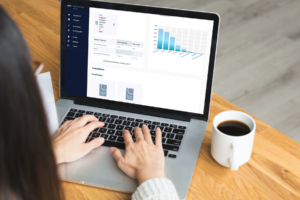
Dynamic Filters
With new filters to discover any object’s provenance, people can dynamically search the Everledger Platform based specifically on inventory availability for physical goods and digital assets.

Public provenance links
Without needing to be logged onto the Everledger Platform, people can easily view provenance reports on digital assets within the Vault when receiving a new, publicly shareable link so that they can share an item directly or more broadly on social media. Asset owners can set the permissions within the asset Provenance Report to be either public or private. Transfers of ownership resets the permissions back to default, which is private or accessible by connected users.
1.9
Everledger Provenance Widget
Tailored to display relevant inventory
With a straightforward Javascript bundle that can be easily customised, e-commerce sites can now embed a widget from Everledger that displays the provenance data and transformation events for any object on the Everledger Platform.
A basic template today for both diamonds and gemstones is available to display origin, planning and cutting, and certification details. All that is needed to get started is to identify the digital asset IDs on the Everledger Platform and provenance details relevant to the brand experience for an API widget that’s site specific. The Everledger Provenance Widget that’s used in one’s own site to display relevant inventory is tailored for a given brand and is not able to be copied and applied within another site.
Public Links
Retailers and marketplaces can now offer links to provenance reports for any object as it’s displayed either within the Everledger Platform or on Provenance Proof, another open source blockchain platform by Everledger. Previously, the only way to access provenance information around objects on Everledger’s platforms such as diamonds or gemstones requires authenticated log-ins or API calls. With growing integrations of online marketplaces and aggregators however, producers can determine the inventory they wish to make publicly available. Public links widen a producer’s reach and help to set their inventory apart with origin, compliance, and sustainability data.
Everledger Identify
Now within the Everledger Platform’s Identify feature (a progressive web app for blockchain-backed product authentication), consumers of participating products can easily sign up for their own Vault by confirming their email address. Without the need to be onboarded to the platform itself, anyone can now store within their Vault the digital ownership of objects which they can also transfer to anyone else to support peer-to-peer trading and secondary market transactions. The Vault can be accessed either by web address or directly by tapping an object’s NFC symbols or scanning its QR code.
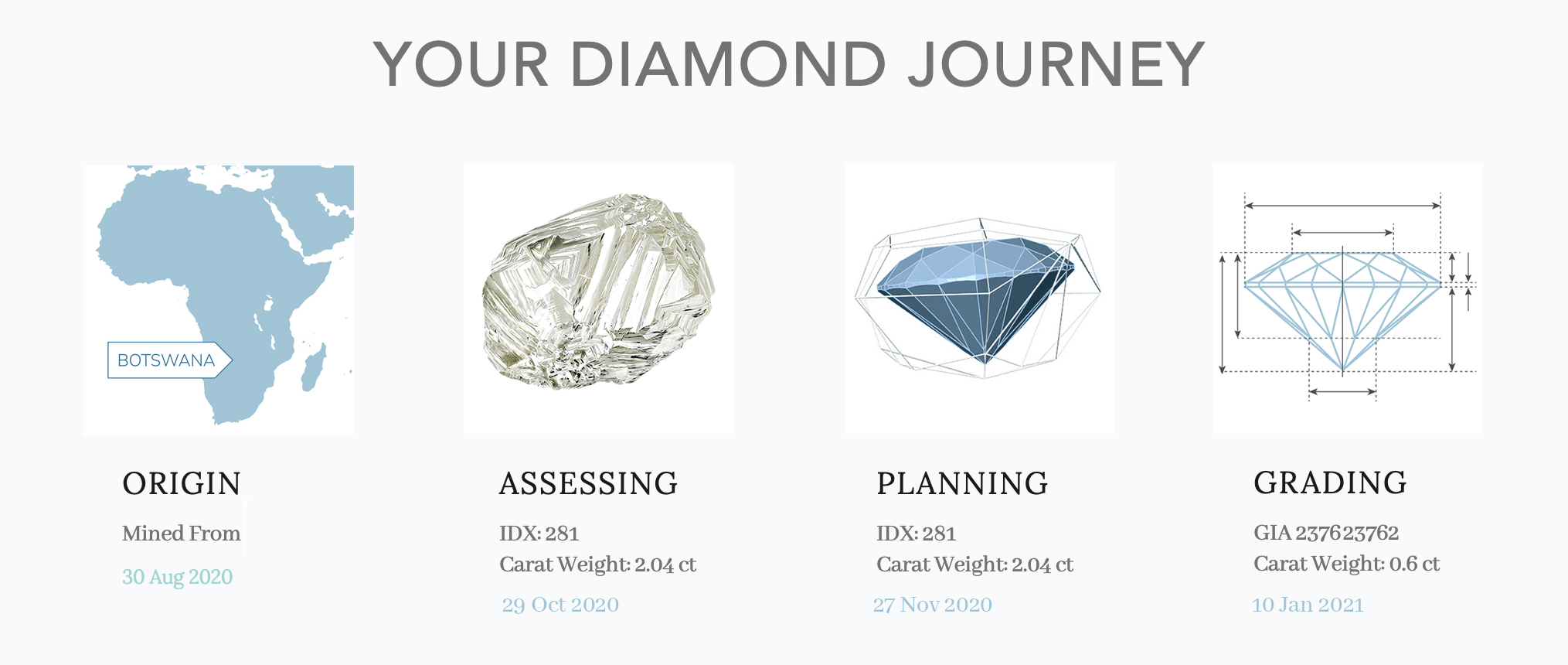
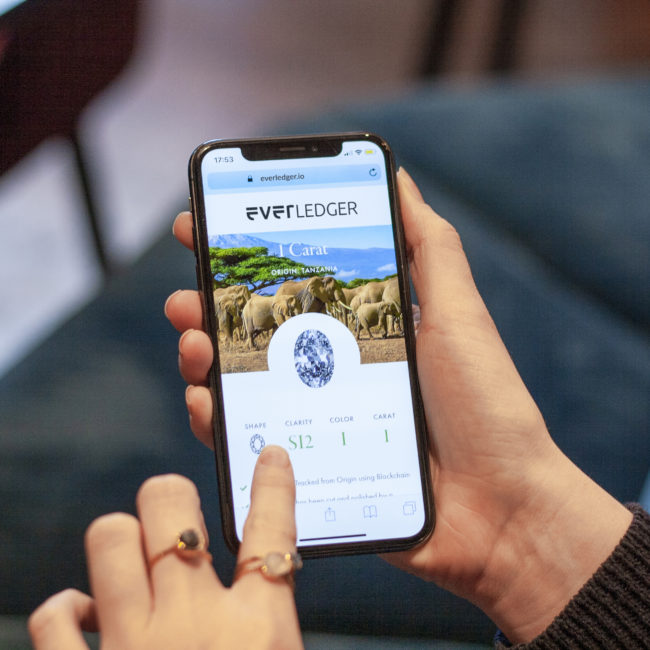
1.8
Availability of Assets
As the blockchain provides for an audit trail of persistent object identity over time, the Everledger Platform is as much an exchange of assets with immutable provenance data as it is a repository for that data. Today, people can now filter search results to display either all assets or only those that are available for sale, a complete view of all the available stock from all suppliers versus a long-term registry of diamond data on the blockchain.
Use Case: Dharmanandan Diamonds
In May, Dharmanandan Diamonds (also known as DDPL) places an extensive listing of its inventory on the Everledger Platform, offering a wide variety of diamond origin and high-resolution imagery capturing transformation events from planning to quality control. Retail buyers seeking new sources of value in their diamond stock can now easily refine diamond inventory by availability as well as reference back to diamonds that are no longer available for sale not unlike looking up a grading report, as their records will now always available to participants.
New Filter Capability for the Vault
Filters are an essential way to search within an inventory for a selected item. Now included in the Vault are simple filters initially serving those categories specific to the gem trade: Gem Species, cut, weight, colour, and unique Identifier.
QR Enabled Certificate of Provenance
With just a single click from the Vault, data contributors within the colour gem trade can export a public PDF report of polished gemstones that details the same timeline of provenance events available to permissioned users online. By either making inventory public with a toggle or by generating a QR code specific to the gemstone ID within each report, anyone in the supply chain can access the digital experience, share the gem via email or social media, and contact the gem’s owner from a mobile device.
Use Case: Provenance Proof
This approach to public sharing is presently available in Provenance Proof, another open-source blockchain platform from Everledger in collaboration within the Gubelin gem lab. Here, traders and retailers accustomed to accompany certificates and paperwork are more easily introduced to the virtues and capabilities of digital ownership without having to first be network participants.
1.7
Make accurate storylines of provenance easier than ever to tell
New feature release: Everledger Identify
Authenticate, transfer, and track products by creating unique object IDs and custom digital experiences accessed with mobile device interaction. Beginning in April 2021, manufacturers can provide clear evidence of production details for object-level provenance records added to the blockchain as a part of the Everledger Platform.
Within this first version, intelligent labelling is incorporated in the object, where downstream participants can access records with mobile devices.
New feature release: Identify
Authenticate, transfer, and track products by creating unique object IDs and custom digital experiences accessed with mobile device interaction. Beginning in April 2021, manufacturers can provide clear evidence of production details for object-level provenance records added to the blockchain as a part of the Everledger Platform. Within this first version, intelligent labelling is incorporated in the object, where downstream participants can access records with mobile devices.
Making provenance records public
Automatically generate a unique URL for an item’s provenance record and enable partners and customers alike to access a story of immutable truth without being logged in to the platform themselves. Each digitized item has a unique URL which can remain private or be shared via email or social media.
Use Case: Provenance Proof
In the trade of gemstones, miners, cutters, and retailers use public links on Provenance Proof to share with customers the authentic origin and many transformation events a gem sees from mine to market.
APIs to support exchanges
Everledger APIs are in use to render provenance data on diamonds from several global suppliers to support industry aggregation sites and exchanges, where buyers and sellers are efficiently connected. Sites can also reconcile the provenance data that is available on existing inventory, allowing for blockchain-backed diamonds as new search criteria for the same stock.
With upstream diamond providers now including standard indicators of provenance data within their stock, large exchanges can regularly call on Everledger end-points to update their own stock and provenance lists. Exchanges can also use Everledger APIs to invoke digital transfers of ownership immutably recorded to the blockchain each time a diamond within their site is purchased.
Use Case: Rare Carat
Rare Carat is integrating Everledger Platform core features to display available diamond provenance data and ensure traceability of a diamond back to its country of origin. With Everledger APIs, exchanges such as Rare Carat can easily show that their diamond listings are in compliance with regulations and thus bolster claims of ethical sourcing with their customers.
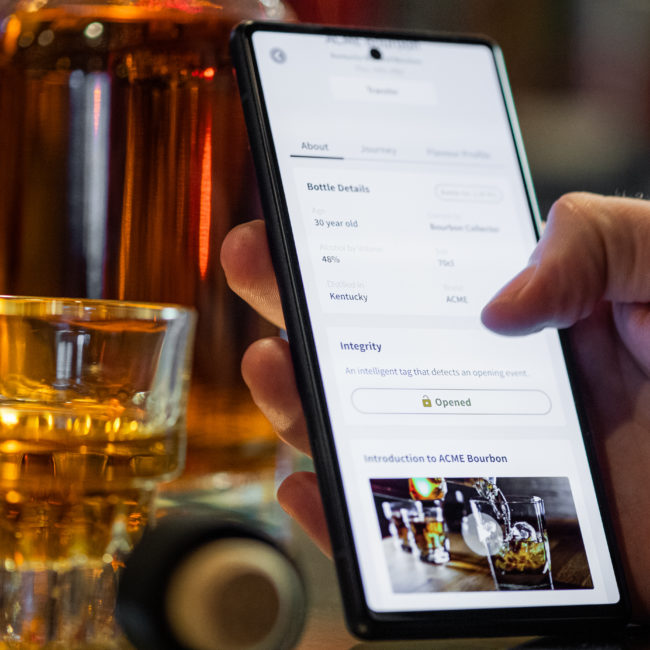
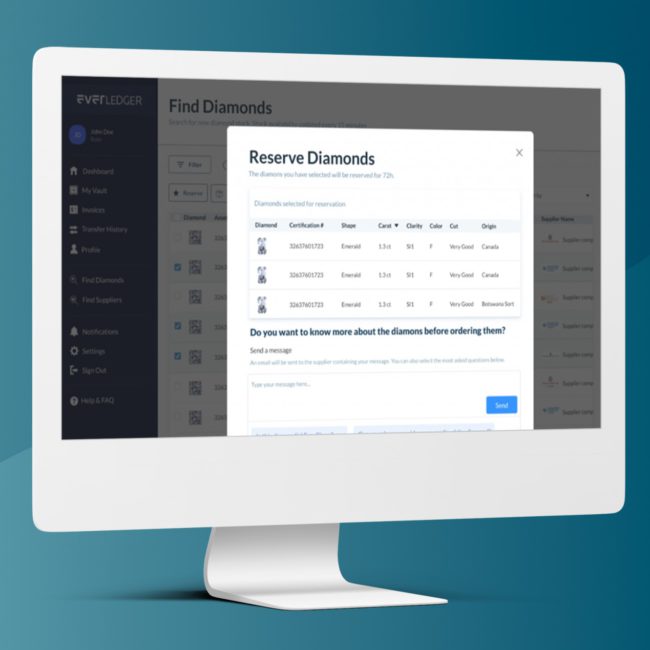
1.6
Everledger Platform Feature Enhancements
In March, we introduced some updates to the Everledger Platform that add convenience in the discovery and inquiry of objects with provenance.
Quick-Look View
A new quick-look view within the platform’s Search & Find feature offers a snapshot of an asset’s core components with the ability to inquire or share without the need to load its full provenance record. For diamonds, this includes an image and/or video of the stone with basic grading information and the ability to reserve, order, or share the asset.
Reserve
Checkboxes can now be utilised to activate a control panel for easy reserving, ordering, or sharing of an asset. The reserve feature requests to suppliers that checked diamonds be held for 72 hours while questions regarding price, terms, or other supporting media are answered (popular questions are conveniently pre listed as suggestions). Such requests to supplier profiles and subsequent answers are managed with email.
Enhanced Story Views for Provenance Proof
In partnership with the Gübelin Gem Lab, the provenance record of rough-to-cut coloured gemstones now includes more detailed information around each transformation event in the supply chain along with rich images and video that captures the people and places along its journey.
New Story Views for Stones and Parcels
In partnership with the Gübelin Gem Lab, the provenance record of rough-to-cut coloured gemstones now includes more detailed information around each transformation event in the supply chain along with rich images and video that captures the people and places along its journey.
Printable PDF File
As an extension of the sales offering, participants can export a PDF summary from Provenance Proof that highlights the story view on the platform. As a one-page document to physically hand to a buyer, the document encapsulates the provenance story in a format and with a similar quality to a gemstone certification, and is only available to the owner of the gemstone to print.
1.5
Feature Enhancements for Web 3.0 Brands
By bridging virtual technologies and the real world, the Everledger Platform helps brands to better connect with consumers through their digital lives. For emerging technology-focused consumer labels such as MCQ, Everledger enables both designers and consumers to securely register and trade clothing.
Use case: MCQ
As a tech-integrated streetwear label, garments within each distinct collection have blockchain technology embedded in the tag, which can be tapped with a smartphone to confirm the authenticity of the item and register it to a digital wardrobe. MCQ also functions as a ‘cultural accelerator and global community of creatives,’ where an exchange of ideas provides for an open editorial platform, where collaborators and collectors interact to evolve the label.
Mobile first, now with desktop views
In what originally launched as a mobile experience for object-level authentication at the point of sale, MCQ has grown into a community of shared interests with a growing number of participants preferring trusted interactions from their desktop. This month, all of the experiences once optimized for mobile-only are now equally accessible from all other devices.
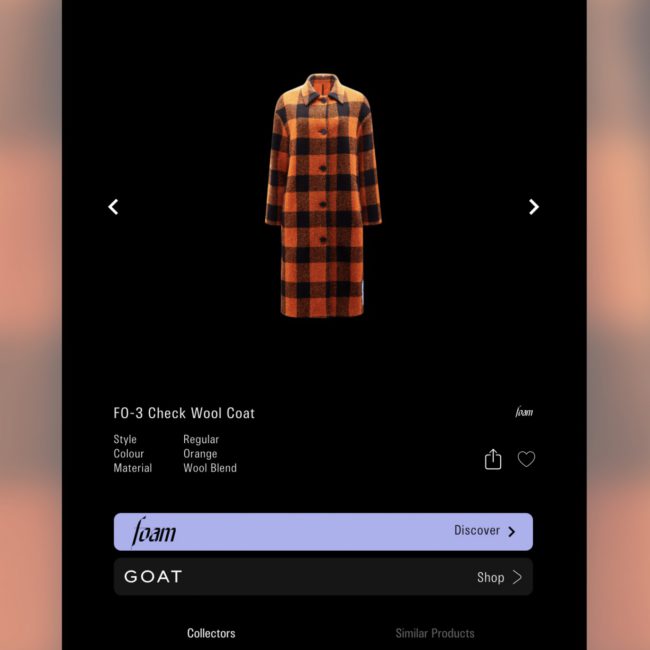
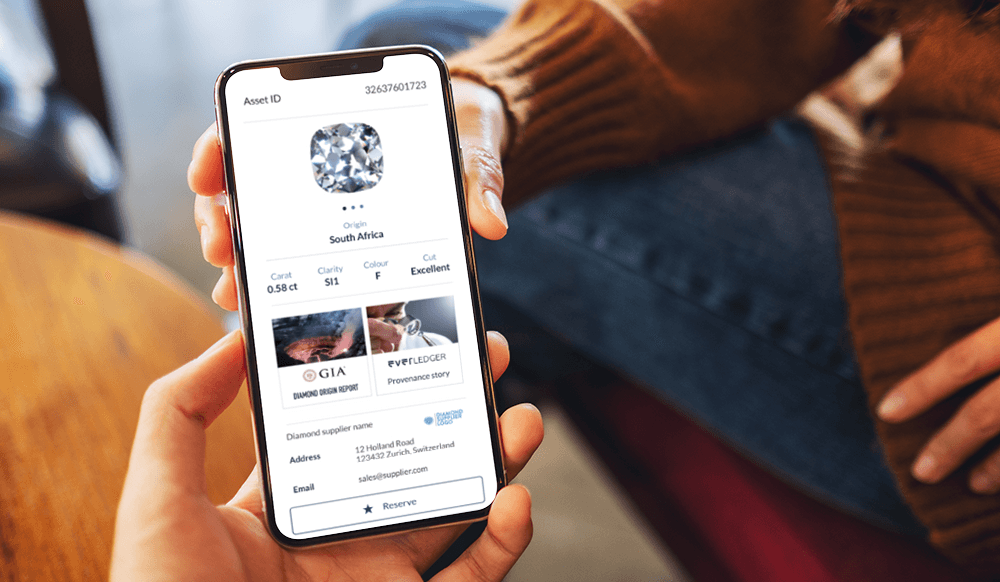
1.4
SMS integration for community events
Everledger’s integration with SuperPhone goes beyond two-factor authentication and customer onboarding with its support of registering community members for invite-only events. For MCQ, regular releases of collections, or ‘icons,’ are live celebrations on Zoom, with exclusive access to musical performances accessible only to the MCQ community.
1.3
Everledger Platform
With the Everledger platform, businesses can substantiate claims about a product’s origin, supply chain, and production practices. By making asset information easily accessible and verifiable, and utilising the best modern technologies to do so, the platform enables supply chain actors and consumers unprecedented transparency and trust around the origin, characteristics, and authenticity of their purchase.
A blockchain platform for diamond traceability
Suppliers and retailers can further evidence the origin, compliance, and sustainability metrics of their diamonds to conscientious consumers. Consumers can also have access to all this information on any device.
For Suppliers
Easily discover retail buyers seeking new sources of value and be rewarded for your investment in sustainable and ethical business practices.
- Contributing diamond data is streamlined. With an established API interface, suppliers can choose the onboarding option that’s right for them.
- Control who sees what. Access control lists allow suppliers and retailers to determine different rights for their data on the platform.
- Efficiently manage shared inventory. Securely share visibility of the same stones with retailers and trust that availability is universally updated when a transfer of ownership occurs.
For Retailers
Build a profile around compliance and sustainability that’s reflective of your purchase criteria and protect your brand’s reputation.
- Go beyond the ‘4 C’s.’ Add compliance, country, and the cognisance of mining and polishing events as entirely new dimensions of value.
- Have greater visibility into your suppliers. See overall inventory, sustainability metrics, and diamond compliance at a glance.
- Confidently assert claims made. Leverage an immutable audit trail to substantiate certificate claims with third parties.
Technology Modules
The Everledger platform is a network to build more trust in your diamond trade. Using blockchain and ISO27001-compliant standards-based mechanisms for authentication services, users can ingest and extract secure diamond data (including characteristics, images, videos, invoices, certificates, and other compliance documentation). Below is a summary of those key technologies used with the first release of the Everledger platform.
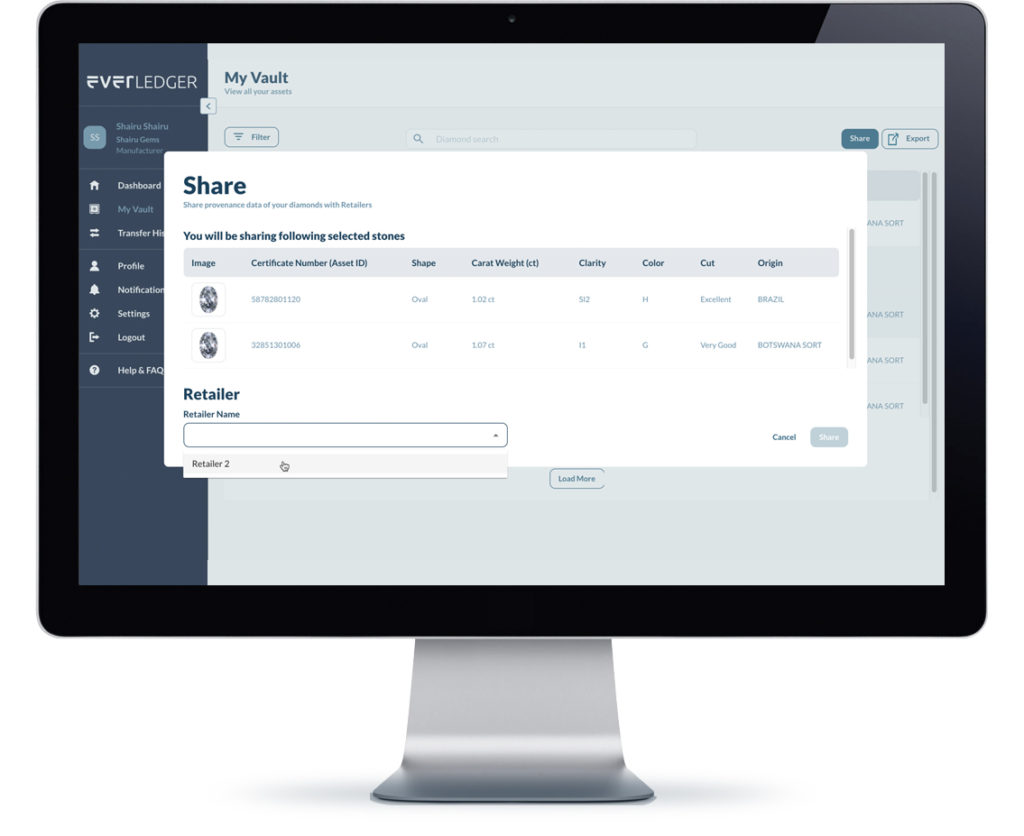

1.2
Easy on-boarding
Everledger Data Pipeline (EDP) – For Data Providers
EDP allows data providers to submit data to the EP system by either JSON format, or a file (CSV), which is detailed within the Data Ingestion API. This data can be then pushed to Everledger Platform, e-commerce sites, mobile apps, or ERP systems. EP is presently able to validate and process 24,000 stones per day. Developer tools will be centrally located within EP.
New APIs
As new generation diamond consumers become less inclined to pay traditionally high prices, the way in which diamonds are produced, distributed, and sold is changing. Everyone in the value chain benefits from the ability to connect, discover and demonstrate diamond value with blockchain-backed provenance records — or a diamond’s ‘digital twin’— alongside physical and virtual inventory.
Data Ingestion API
The Data Ingestion API allows a data provider such as a supplier of loose diamonds to submit data to the EP system by either JSON format or within a file (CSV) and supports a range of media files. Data uploaded to EP may use one of the pre-existing Everledger template schemas or may register their own custom schema with Everledger. Data that is uploaded is met with comprehensive system prerequisites that validate the incoming compliance documentation and certificates before importing the data to the ledger.
Object API
The Object API allows customers to query the digital twin of loose diamonds on the Everledger platform by calling on end-points such as the Everledger ID or other attributes like the associated 3rd-party-issued certificate number. Requests read all of the diamonds in the Vault of those suppliers with whom an organization is connected and returns all the necessary information to confirm the validity of a diamond record.
Provenance API
The Provenance API returns a complete provenance report of a diamond, including transformation events from rough to polish and the certificate report. Requests can be made to show all or just part of a diamond’s provenance record. This API can also be used in the future in combination with the Everledger Fraud Algorithm to detect those diamonds that have been sold multiple times.
Transfer API
The Transfer API allows customers to reassign the ownership of a digital asset to a new owner over the blockchain. Conversely, the Transfer API can be used to facilitate returns to a participant upstream of the current owner.
1.1
Optical character recognition & data validation
Efficiently analyze data sets and meet documentation requirements with advanced optical character recognition (OCR) capabilities. Everledger will provide some minimum checks for all assets added to the blockchain to demonstrate a legitimate sale per international norms and international trade regimes.
Smart matchmaking
Connect with sources of market value. By setting up profiles reflective of diamond quality, origin, compliance standards, and even carbon impact, you can be matched with relevant trading partners and gain access to new inventory and markets. By first being connected with the right suppliers, retailers can easily see the inventory they want. Diamonds can be filtered by keyword search, standard quality characteristics, sustainability efforts, and compliance standards.
Sustainability and compliance performance
Suppliers, retailers, and even individual diamonds on EP can demonstrate compliance claims relating to legal and human rights performance by mixing and matching the many data sets, certifications, and due diligence reporting across the diamond trade — specifically the Kimberly Process Certificate (KPC), Responsible Jewelry Council (RJC) Code of Practice, and World Diamond Council (WDC) System of Warranties.
GHG Reporting
A shared and manageable claim relating to environmental performance for many users is their carbon footprint from direct and indirect greenhouse gas emissions downstream — as well as leveraging the use of renewable energy. This can be gauged and reported within EP by both uploading documents and ingesting 3rd party audit data relating to energy use that are reviewed against Everledger’s data governance. Organizations can also rely on integration partner Carbon Fund to calculate footprint, and make donations for offsetting.
GIA Diamond Origin Reports
The Everledger platform now makes the GIA Diamond Origin Report (DOR) widely discoverable and easy to display with one-click. GIA’s DOR provides a scientific rough-to-polish verification and origin provenance and the robust grading certification for which the GIA is renowned. Through the Everledger platform, it is easy to access integrated education materials on the people and places that helped create each diamond and to provide this independent substantiation at the point of sale.
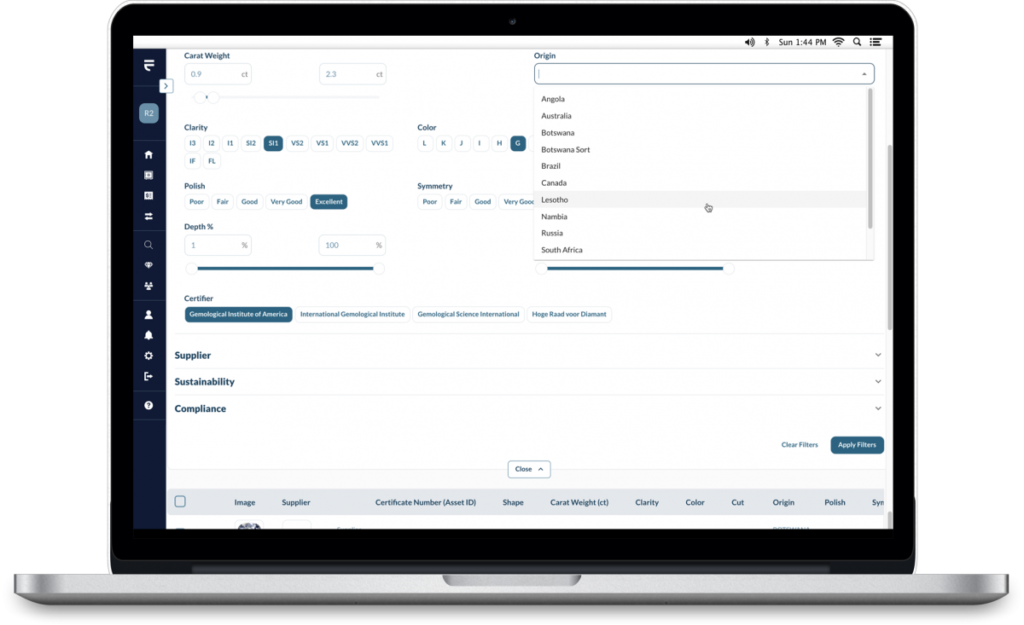
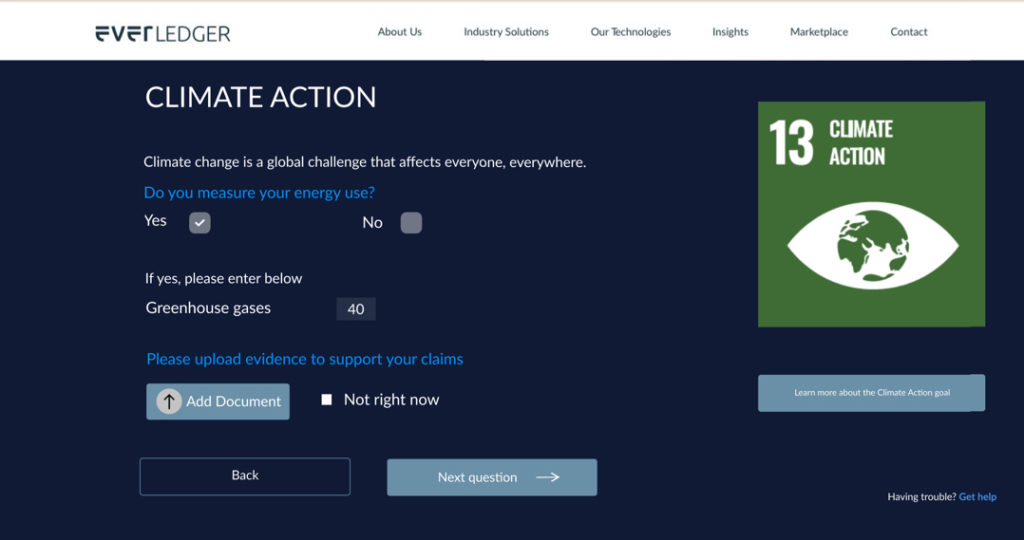
1.0
Getting started
The Everledger platform brings to the diamond industry a clear line of sight and the validating power of the blockchain so that suppliers and retailers can more efficiently respond to consumer expectations for transparency and trust. Within this first release of EP, people can upload data around their diamonds, and others can explore that inventory, transfer ownership of a diamond’s digital twin, and show its full provenance record. Discover in this section how profiles are set up, analytics are accessed, and the platform is generally used.
Profile Set Up
Onboarding to EP is now self-managed. Simply sign on at platform.everledger.io to create either a supplier or a retailer account. Tailor your experience by identifying the business objectives most valuable to your trade, such as sustainability, traceability, circular economy, technology, data security, provenance, or simply gaining new connections. As many organizations today are already aligning their future direction alongside the United Nations Sustainable Development Goals (SDGs), EP also makes it easy to understand and express how these global challenges we face are being met — including poverty, inequality, climate change, environmental degradation, peace, and justice.
Customer screening Process
As a first step, Everledger’s Customer Screening process establishes the bona fide credentials of parties wishing to participate on the Everledger platform. This includes entity identification, individual identification, and an assessment of risk. Once our due diligence documentation is completed (typically within a 24-hour period), access to supplier and retailer profiles is granted along with the ability to transfer ownership of digital assets.
*The Everledger platform only accepts corporate email accounts (as opposed to personal Gmail or iCloud addresses) to sign up for this reason.
For Suppliers
Supplier organization’s can edit corporate logos and cover images by confirming the city of operation within their profile. To estimate organizational carbon emissions, upload documents related to energy consumption or use the Carbon Fund calculator and simply follow the steps to report and donate to offset. To express industry compliance, upload certificates related to the organization and its transactions.
Sample compliance and sustainability documents:
- RJC Code of Practice (COP) is the overarching standard for social and environmental responsibility in accordance with the UN SDGs. Members are subject to 3rd party audits that verify conformance.
- The System of Warranties requires all diamond suppliers and diamond jewellery manufacturers to pass on a warranty statement each time diamond goods change hands, thereby assuring the next buyer the diamonds originated within the Kimberley Process system.
- Greenhouse Gas (GHG) and usage can be calculated by uploading documents relating to energy consumption, waste production, and transportation that are reviewed using OCR and comply with Everledger’s data governance.
- Diamond analytics like quality characteristics to the origin and certificate types will populate automatically once the KYC and data uploading processes have been completed. Retailers will discover supplier profiles that fulfill their purchase criteria.
For Retailers
Add logos, update cover images, and set purchase criteria based on the diamond quality characteristics, origin, organizational compliance standards, or sustainability metrics needed for either corporate social responsibility or for use in-store or online. Once the KYC process is complete, access the dashboard for an overview of the suppliers which meet profile criteria and begin accessing stock within Search & Find.
Uploading Data
Suppliers can upload provenance data related to diamond stock via API or CSV that increases commercial visibility and opportunity to sell diamonds with reliable traceability (see Data Ingestion API for details).
The data schema for diamonds includes standard industry identifiers such as grading report numbers, as well as invoice, parcel, lot, packet, and certificate attributes. Data is normalized to ensure it is able to be uniformly queried, used in data analysis, and visualised.
With all the necessary elements to satisfy data governance and storage on the blockchain provided, the processing time and status for uploading diamond data presently takes one business day for every 24,000 stones.
Rigour applied to uploading data
As Everledger provides a network of immutable, trusted data related to the origin and lifecycle of products people care about, the usefulness of the platform to all participants requires that all data contributed is set up correctly.
Data committed to a blockchain cannot be later erased – corrections can be made, but the history remains. Therefore it is worth upfront effort to ensure corrections are minimised, and automated ingestion mechanisms are tested to work smoothly.
Suppliers can choose what data they wish to contribute and how they wish to contribute it. We can advise participants based on the claims they wish to make.
Exploring Inventory
With secure connections to suppliers, retailers can gain a high-level overview of stock on the platform by quality, compliance and sustainability metrics. In Search & Find, retailers can employ traditional filter criteria such as carat weight, shape, cut, clarity, and color as well as sustainability, compliance and origin — including those stones with GIA Diamond Origin Reports.
Retail buyers can contact suppliers directly for holds, purchases or arrangements for consignment.
Toggle Title
Transferring Ownership
Within the organization’s Vault are the ‘digital twins’ of each diamond, either uploaded or purchased, where forensic data, provenance events, and certifications are kept.
The transfer of ownership of a diamond’s digital twin and provenance record is made from the supplier’s Vault and into the Vault of a retailer. This change in custody is recorded on blockchain and is what provides for an authentic and accurate provenance story for each gem. Retailers are alerted to successful transfers by email notification, with an invitation to access their Vault. Similarly, retail jewelry customers are invited to access their own vault on the Everledger platform upon a diamond’s purchase.
Transferring Ownership
Within the organization’s Vault are the ‘digital twins’ of each diamond, either uploaded or purchased, where forensic data, provenance events, and certifications are kept.
The transfer of ownership of a diamond’s digital twin and provenance record is made from the supplier’s Vault and into the Vault of a retailer. This change in custody is recorded on blockchain and is what provides for an authentic and accurate provenance story for each gem. Retailers are alerted to successful transfers by email notification, with an invitation to access their Vault. Similarly, retail jewelry customers are invited to access their own vault on the Everledger platform upon a diamond’s purchase.
For Suppliers
Suppliers can query all of their diamonds within their Vault and transfer ownership of each stone as a blockchain enabled, time-stamped event that sees data stored within the supplier’s channel moved into the retailer’s channel by simply entering the recipient’s email.
For Retailers
Retailers can also register and track ownership at the point of sale when transferring diamonds to their customers. This immutable record of all changes in custody are what provides for an authentic and accurate provenance story for each diamond.
Returns are easily made using the Transfer API or manually in some cases, where the chain-code is updated to reflect ownership status.
Sharing & Viewing Records
With a complete provenance history of each diamond, there’s a lot more to show around the diamond, including, origin, allotment, rough state, planning, cutting, polishing and certification. While this is all information that diamond suppliers readily document, never before have retailers had access to authentic stories and validation of origin that demonstrates the rarity of each diamond. In showcasing certification data within the provenance record, retailers can provide the most complete picture possible either in store or online.
For jewelers, this new standard in answering questions about origin provides customers with a story to share. Provenance records allow consumers to not only communicate the value and ethics behind their purchase with others, but it also provides retailers with a dynamic, long term connection with those customers. In the consumer Vault, proof of purchase and warranty information can also be preserved with retailer participation.
Accessing Analytics
Suppliers and retailers on the Everledger platform alike can be rewarded for good business practices by sharing operational and supply chain analytics. Showcase and view inventory as a snapshot of total diamonds and transactions made on the platform, as well as how it measures up against quality characteristics, sustainability efforts, and compliance standards. The analytics dashboard also offers suppliers better visibility into where supply and demand is headed with emerging trends, and for retailers the visibility as to who has the inventory and metrics that meet those changing retail needs.
Platform core features
- Inventory overview
- Supplier / retailer overview
- Sustainability metrics
- Diamond compliance
- Trusted network
- Data governance, configuration, and API onboarding
- Node hosting and channel management
- Access controls
- Managed connections
Vault features
- Filter inventory
- Transfer ownership
- Access transfer history
- Sales user login
- Provenance records
- Complete provenance and supply chain data
- Copy of certification
- Social sharing
